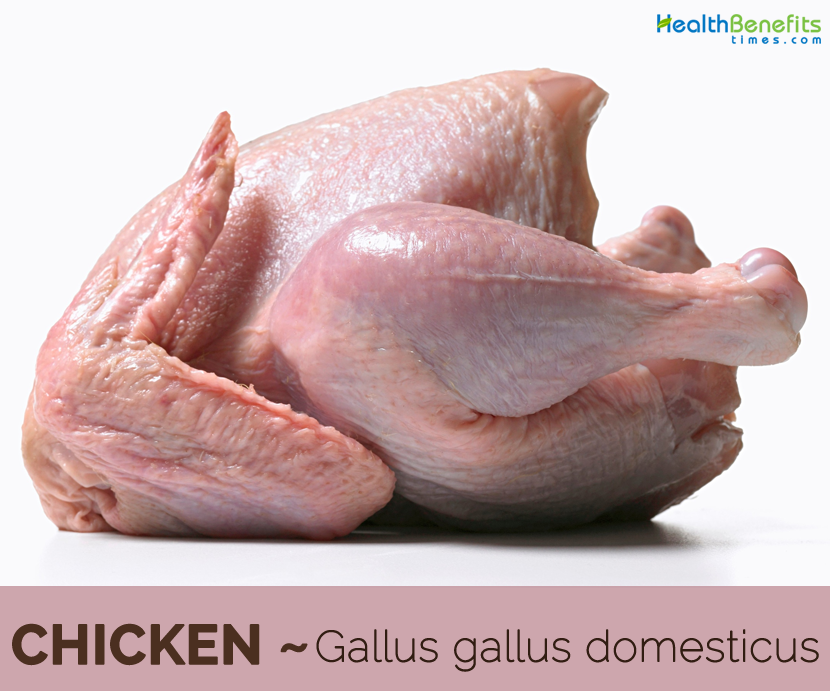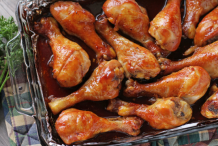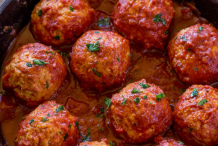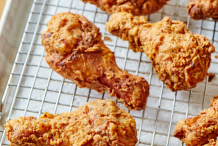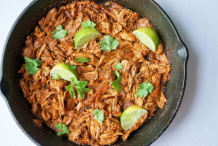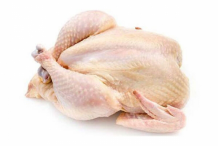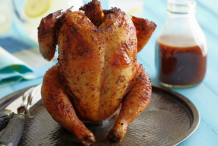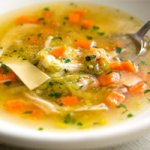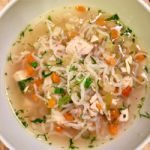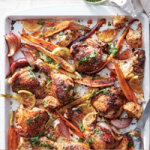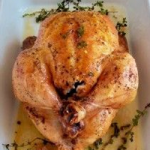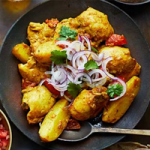A chicken is a type of bird. There are over 150 varieties of domestic chickens. They were domesticated about 8000 years ago. It is believed that chickens were first tamed in India thousands of years ago, mostly for cockfighting and later for meat consumption. Later, chicken spread to other parts of Asia, Africa, Europe, and eventually America, where it was transported by the early colonists from Europe. A chickens’ heart beats 280-315 times a minute. A chickens’ body temperature runs at 102-103 degrees F. A rooster takes 18-20 breaths a minute and a hen takes 30-35. Many animals eat chickens; include skunks, owls, raccoons, hawks, snakes, opossums, bobcats, and human beings.
Chickens like most animals feature in religious belief and mythology. There is a pleasant belief in Islam that when a cock crows it is because he has seen an angel. In the Hadith, Muhammad commands, “When you hear the crowing of cocks, ask for Allah’s Blessings for they have seen an angel.
The chicken has a great importance during the Hindu cremation ceremony in Indonesia. A chicken is tied by his or her leg during the duration of the ceremony so that any evil spirits may be channeled into the chicken rather than the family members who are present. After this ceremony the chicken is returned home and is not treated any differently.
Body Description
The rooster is larger and more brightly colored than the hen; he also has a larger comb. Roosters make a very loud crowing sound and can be quite aggressive. The vibrant male has long, golden-orange to deep-red crown and neck feathers, and a dark metallic-green tail with a white tuft at the base. The under parts are a dull black while the upper parts are a combination of glossy blue-green, rich dark red, maroon-red, fiery orange, rufous and blackish brown. The colorful cock also has vivid scarlet-red facial skin, throat, two lappets and heavily dented fleshy crest (comb), and red or white ear patches on the sides of the head. The rather drab female is a dull brown-gold color with a partly naked, pale red face and throat.
Food
Chicken are herbivore and insectivore animals and have a varied diet. They normally eat insects, worms, fruit, seeds, acorns, grains, slugs, snails, and many other foods. They have a well-developed gizzard (a part of the stomach that contains tiny stones) that helps to grinds up their food.
Egg
Chickens lay different colored eggs, from white, to brown, to green, to pink, to blue. The color of a hen’s first egg is the color she will lay for life. It takes 24-26 hours for a hen to lay an egg. The color of a hen’s egg is determined by the breed of chicken—and the color of their ears! The color of the chicken’s ear lobes indicates the color of the egg, red ears means brown eggs, and white ears means white eggs.
Sound
The morning call you hear on the farm every morning is actually the rooster crowing “cock-a-doodle-doo”. The female is called a hen and she goes “cluck-cluck”. The young are called chicks and they go “chick-chick”. Chickens make sounds with actual meaning. They give different alarm calls when susceptible by different predators. A rooster will attack anything that he thinks will harm the hens. Their spurs (positioned at the back of their leg) can cause a very painful puncture wound.
Reproduction
The main breeding season of the chicken is spring and summer. The chicks will start their lives in the warmth of the summer sun. An egg is laid each day. For twenty-one days before hatching, the chick will develop inside of the egg. On the first day, the heart and blood vessels of the chick develop and start to work. At the end of the first day, the head starts to take shape. By the fourth day, all organs of the future chick are present. On the fifth day, external sex structure developed. By the thirteenth day, the skeleton begins to calcify using the calcium from the eggshell. From the time when the egg is laid until hatching, the chick feeds on the yolk that surrounds him. The yolk penetrates in the chick body by the umbilicus. On the twenty-first day, the chick is now fully developed, starts to break through his thin shell. This action can take anywhere from ten to twenty hours.
History
History of chickens (Gallus domesticus) is still a bit of a puzzle. It is believed that chickens were first domesticated in India thousands of years ago, primarily for cockfighting and later for meat consumption. Scholars agree that they were first tamed from a wild form called red junglefowl (Gallus gallus), a bird that still runs wild in most of southeast Asia, most likely hybridized with the gray junglefowl (G. sonneratii). That occurred probably about 8,000 years ago. Recent research suggests, however, there may have been multiple other domestication events in distinct areas of South and Southeast Asia, southern China, Thailand, Burma, India and eventually America, where it was transported by the early colonists from Europe.
Since the wild ancestor of chickens is still living, several researches have been able to observe the behaviors of wild and domestic animals. Domesticated chickens are less active, have fewer social interactions with other chickens, are less aggressive to would-be predators, and are less likely to go looking for foreign food sources than their wild counterparts. Domestic chickens have increased adult body weight and simplified plumage; domestic chicken egg production starts earlier, is more frequent, and produces larger eggs.
Until the 19th century, chickens were often domesticated in households, both for their meat and their eggs. An excess amount of meat and eggs were used in bartering systems. In the latter part of 19th and the early 20th century, household chicken farming gave way to chicken farming as a big business due to the increasing demand from cities.
Types of Chickens
We can find different types of chicken throughout word-wide. There are a lot of birds in this world, and chickens are the most populated one. Each of this chickens produce fresh eggs, it is up to you to decide which one you would like to pet and have in your backyard chicken coop. We want to help you decide what chicken will fit your chicken coop perfectly.
1. Ancona
Characterized by its mottled feathers, giving an overall white spotted appearance on a beetle green background, the Ancona gets its name from Ancona province in Italy. The red comb may be single or rose and in the female will fall to one side of the face and is complemented by neat earlobes that should be white. The legs are mottled yellow, with four evenly spaced toes. It will produce a good quantity of eggs as a reward for your efforts and can become domestic to a degree.
2. Araucana
Named after the Indians of Arauca province in Northern Chile, the Araucana is an easygoing but nonetheless active bird able to be kept both in a closed run and free-range. Colors include lavender, blue, black-red, duckwing, pyle, crele, spangled, cuckoo, black and white.
3. Barnevelder
Originating in the Barneveld district of Holland, these lay dark brown eggs which are one of the main attractions to this robust breed. It is easily contained behind a medium-height fence. It a very attractive bird for exhibition and garden alike. Colors include black, double laced (black with a red-brown edging), partridge and silver.
4. Black Rock
Black rock is an easy-going, extremely hardy bird, predominantly black with copper neck markings, and capable of laying around 280 brown, thick-shelled eggs per year. At the end of the laying period you’ll get a well-fleshed bird for the table.
5. Brahma
The King of Chickens, the Brahma was developed originally in America from the Asian Shanghai fowl and Indian Grey Chittagong, and there was much competition and debate between breeders until the official name of Brahmapootras was adopted (later shortened to its current spelling). Colors include dark, light, white, gold, and buff Columbian. Easily tamed, they are ideal in the garden, as a low fence will contain them and they are very tolerant of each other, the cocks being relatively quiet. Hens will lay a good quantity of small eggs throughout the winter when other breeds are not laying.
6. Cochin
Cochin is an immense bird with a deep shape emphasized by feathering; the Cochin was originally a dual-purpose bird, being excellent for table and a profuse layer. Color includes black, blue, buff, cuckoo, partridge, grouse and white, and the legs and feet are profusely feathered. Easily kept in little space, fences need not be high as they don’t fly well.
7. Cream Legbar
The females possess a well-defined pale head spot and are instantly recognizable. In males, the head spot is rougher and spreads all over the body, giving them a lighter appearance. Cream legbar is a crested breed that has Araucana in its ancestry and lays beautiful colored eggs in hues of blue through green.
8. Dorking
Dorking is one of the oldest British table breeds, having a lineage dating back to Roman times. Distinguished by its five toes, this bird has been described as quiet and stately and is recognizable by its rectangular shape when viewed from the side. Colors include cuckoo, dark, red, silver grey and white.
9. Dutch Partridge
Dutch Partridge is the smallest of all the bantams, but still lays a decent-sized egg. Needs plenty of room to be kept busy, but will be quite happy even if kept in a smaller space. The males can be shrill and persistent crowers. Colors include partridge in gold, silver, yellow, blue/silver, blue/yellow, blue, cuckoo (crele) and red-shouldered white (pyle) as well as black, white, blue, cuckoo, and lavender – testament to its popularity.
10. Hybrids
These are the typical brown layers which inhabit battery farms and are often seen in farmyards, commercially bred for increased egg production utilizing as little feed and space as possible. Hybrids bred for free-range are typically more robust and hardier than those bred for cage production. Hybrids are the best option.
11. Japanese Bantam (Chabo)
Japanese Bantams are truly one of the ancient breeds and have no large fowl counterpart. They have the shortest legs of all the breeds and can be normal-feathered, Silkie-feathered or frizzle-feathered. The large comb of the males, upright tails held at 90° to the body and waddling walk make them a very amusing sight in the garden, where they’ve been compared to galleons sailing across the lawn!
12. Marans
This breed from the French village of Marans is famous for its glossy dark brown eggs, which are very desirable. Active but wary birds, they respond well to calm handling but never become fully hand-tame. Colors are black, cuckoo, golden cuckoo, and silver cuckoo.
13. Marsh Daisy
Created in Southport in the 1880s by crossing an Old English Game bantam cock with Malay hens and then mating a cock from this mating with black Hamburg/white Leghorn cross hens. A resulting cock was then crossed back to the Hamburg/Leghorn hens and the offspring line bred until around 1913, when Pit game and Sicilian Buttercups were used to give us the bird we recognize today. Classed as a rare breed, the Marsh Daisy is seeing a resurgence of popularity amongst people who wish to preserve the old English breeds. Marsh Daisy colors are black, brown, buff, wheaten and white.
14. Modern Game
This breed was developed in England to replace fighting birds after the ban on cockfighting. Bred now for exhibition, Modern Game is poor layers but do make a placid pet if you find their shape attractive. Thirteen colors have been standardized, including birchen, black-red, brown-red, golden duckwing, silver duckwing, pyle, wheaten, black, blue, white, blue-white, silver-blue, and lemon-blue.
15. Old English Game
There are two types of English Game, the Oxford and the Carlisle, the latter having a broader breast. Carlisle comes in 15 colors, the Oxford in around 30. Not a particularly good layer, but a friendly bird and a good choice if you want a breed that children can look after. Although the cocks may fight amongst themselves the hens are tolerant of other birds.
16. Orpington
Originating in Orpington, Kent, in the late 19th century, this was a dual-purpose breed with Langshan in its ancestry, amongst others. Layers were said to be able to produce over 300 eggs a year, which would have made it the egg producer of its time. Large stature makes them a good garden bird, as they don’t fly and can be restrained by low fences around borders. Their only requirement is a dry area to perch, to prevent their under-fluff from getting waterlogged. Standard Orpington colors are blue, black, white and buff.
17. Pekin (Lemon Cuckoo)
Although it’s also known in Europe as the Cochin Bantam, the Pekin is not really a bantam version of the Cochin, as it is too dissimilar. A round and cuddly ball of soft feathers, this must be the children’s favorite as it’s easily tamed and will run towards you in excitement if it thinks a treat is in store. The hens lay few eggs and go broody very easily, making them useful for hatching the eggs of non-sitting breeds. Colors include black, blue, buff, cuckoo, mottled, barred, Columbian, lavender, partridge, and white. Other coolers do exist but have not been standardized, for example the lemon cuckoo.
18. Poland
Recognized instantly by its massive crest, the Poland is truly a sight to see. This is a fairly high-maintenance breed, with a number of conditions being made worse by its crest, such as lice infestations and eye problems, although there is movement within the breed club both at home and abroad to reduce the crest to a more practical size and shape.. Standard colors include chamois (buff laced), gold, silver, self-white, self-black, self-blue, white-crested black, white-crested cuckoo, and white-crested blue.
19. Rhode Island Red
Originating in Rhode Island State in the USA, this breed must lay claim to being one of the most popular of all time. It is used extensively in hybridization, due to the ability to identify its chicks by sex linking. This and the fact that its brown eggs are much favored in the kitchen mean that the Rhode Island Red was originally bred as a dual-purpose chicken. Although suitable for an enclosed run, its eggs improve in color and flavor if the birds are allowed to free range. This will also prevent fighting amongst the males.
20. Seabright
Made in the early 1800s by Sir John Sebright to create a laced bantam, the Sebright is unusual in that the male has similar feathering to the female and is said to be ‘henny-feathered’, lacking the typical male plumage; which as a consequence means both males and females are beautifully laced all over. Colors are silver laced and gold laced.
21. Silkie
Silkie is instantly recognizable by its pompom, fifth toe, black skin and profuse fluffy plumage, caused by an absence of barbs on the feathers that prevents them from knitting together. Known for its ability to brood the eggs of other birds, although the chicks can get caught up in the under-fluff and die, so a Silkie cross with harder feathers is better. It is docile and the cockerels placid and not particularly noisy. Colors include white, black, blue, partridge, and gold.
22. Speckeldy
Speckled hen lays about 260 to 270 brown, sometimes speckled eggs per year. It is a placid and friendly, a good all-round chicken.
23. Sultan
A truly ornamental breed descended from a group of birds imported by Elizabeth Watts in 1854, the Sultan is not particularly popular but does have a dedicated following. The breed standard lists a crest, beard, vulture hocks, feathered legs, five toes and white plumage as attributes. Placid and good-natured birds, they should be provided with an enclosed and sheltered run, with specialist drinkers to prevent the beard becoming soiled. The only recognized color is white.
24. Sussex Light
Bred originally as a table bird, hens will also lays a quantity of good-quality eggs, which makes it a useful dual-purpose breed for the kitchen garden and also commercially, as Sussex crosses make fine producers of both meat and eggs. Calm and docile, it’s a good chicken for the beginner and easily tamed. Colors are speckled, brown, buff, light (Columbian), red, silver, and white.
Health benefits of Chicken
Chicken nutrition facts are different from those of many foods, namely, dairy products. That’s why it is hardly replaced in the diet. Below are top health benefits of chicken that might need you to choose chicken immediately for the next meal.
1. Weight Loss
Diets with high levels of protein have been known to be effective in reducing weight and chicken has been one of the main candidates in weight loss. Research and trials have shown that significant weight control was observed in people who regularly ate chicken. (1)
2. Reduced Cancer Risk
Research have found that in non-vegetarians, a higher consumption of red meat, pork/ham increased the risk of colorectal cancer, while in chicken and fish eaters, the risk of developing this cancer in later life was reduced, although the evidence is not conclusive. (2)
3. Common Cold
Chicken is regarded as one of the most traditional options for curing common cold. It helps to relieve common symptoms of these infections, including sore throat or congested nose. In addition, chicken consists of tryptophan which is a special amino acid to make you feel comfortable. Chicken possesses anti-depressant quality, which is very effective for the treatment of common colds.
Intake of warm chicken soup provides relief from common cold, including symptoms like a congested nose and a sore throat.(3), (4), (5), (6)
4.Reduced Cholesterol
Amount of saturated fat and cholesterol found in red meat such as beef, pork, and lamb are much higher than the levels found in chicken, fish, and vegetables. Therefore, the American Heart Association has recommended consuming chicken or fish instead of red meat for a lowered risk of cholesterol and subsequent heart disease development. The AHA also says that consuming chicken or fish must be limited to normal levels, as excessive consumption can also lead to the development of heart disease. (7)
5. Helps To Fight Against Depression
Chicken also contains large amounts of an amino acid called “tryptophan”. It has a soothing effect on the nervous system, and it can stimulate and improve our sleep. In fact, if you feel depressed, you just need to eat some food dishes which are mainly made with chicken to increase the levels of serotonin in your brain, in order to enhance your mood, reduce and ease the stress, and relieve the depression that you are suffering. In fact, large quantities of vitamin B3 contained in chicken can help people improve mood effectively, especially in cold winter days. You just need to boil or roast a small chicken, and you are about to have a nutritious meal which support you well in the battle against depression, stress, and anxiety. This is actually one of the best health benefits of chicken that not many people know!
6. Protecting the Cognitive System
Chicken meat consists of good amount of Niacin, also known as vitamin B3 and has been shown as an effective preventative measure against age-related cognitive decline. According to the Journal of Neurology, Neurosurgery and Psychiatry (JNNP), a regular intake of foods high in niacin, such as chicken, can protect the brain against Alzheimer’s disease.
7. Helps build muscles
Chicken is one of the best non-vegetarian sources of protein. It is lean meat, which means that it contains more amounts of proteins and less amount of fat. A 100g serving of roasted chicken offers you 31g of protein, making it great for those who want to bulk up and build muscles.
8. Control of Blood Pressure
Regular Chicken consumption has been found to be useful in controlling blood pressure as well. This was observed in people with hypertension and in many African Americans, though the diet also contained nuts, low-fat dietary products, vegetables, and fruits.
9. Strengthen Teeth and Bone
Chicken has phosphorus which can keep your bones and teeth healthy and prevent bone loss (as calcium). It can be said that chicken is very good for women who are susceptible to have weak bones.
10. Heart’s Health
Homocysteine is an amino acid that can cause heart disease if it contained at high levels in our body. Therefore, controlling the level of homocysteine is essential to protect the health of the heart. And fortunately, eating chicken breast in a regular basis may help to prevent the increase of homocysteine levels and control them as you desire. Chicken has cholesterol but it also contains niacin which can help to lower the cholesterol levels. Therefore, if you pick up lean chicken flesh and serve it without adding butter or oil, it will be actually very good for your heart.
11. Improve the Health of Eyes
Chicken flesh comes with high levels of retinol, alpha and beta-carotene, and lycopene – the substance which are all derived from vitamin A so that they are very beneficial for eyesight. In fact, eating chicken can contribute to stabilizing and maintain your vision’s health. Therefore, you certainly should add chicken to your daily diet in a regular basis for good, particularly if you are living with some eye problems.
12. Reduces PMS symptoms
Magnesium, a nutrient present in chicken helps soothe symptoms of pre-menstrual syndrome and fight the various mood changes that a woman might experience during her periods.
13. Support the Healthy Tissue Growth
Many people have to face the problems of chapped lips, cracked mouth, sore tongue, or dry skin in the winter. However, if you eat chicken or chicken liver, these issues will be considerably reduced. That is because the chicken and chicken liver contain riboflavin (a type of vitamin B2) which can work to repel dry skin and repair damaged tissues in the body.
14. Boosts immunity
Chicken soup has long been used as a home remedy for relieving cold, flu and other common respiratory infections. Hot steam of chicken soup helps clear nasal and throat congestion while the thick fluid coats the throat to prevent invasion of respiratory linings by microbes to cause infection. Research evaluating this effect suggested that chicken soup prevents migration of neutrophils, a type of immune cells, thus preventing inflammation during common infections and boosting immunity.
Quick Serving Ideas for Chicken
Chicken Salad
Add roasted chicken breast, cherries or cranberries, halved seedless grapes, diced apple, chopped green onions, and boiled mushrooms to a bowl and mix well. Add salt and pepper to your preferred taste. This salad is healthy and easy to prepare.
Chicken Sandwich
Toast 2 slices of bread and spread butter on them. Put slices of cucumber, beetroot, onion, capsicum, and cooked chicken on one slice. Add salt and pepper to taste, and cover it with the second slice. Serve with ketchup or mayonnaise.
Oven-fried Chicken
Take medium-sized cut chicken breast pieces, season them with paprika and salt to your preferred taste. Dip the pieces in egg whites and later dip them into a mix of crushed cornflakes. Grease a baking tray and place the chicken pieces on it. Bake for 30 minutes and serve.
Recipes
1. Chicken Soup
Ingredients:
- 1 chicken, cut into around 8 – 10 pieces (remove its skin, leave bone in)
- 8 cups of chicken broth (unsalted or homemade, low-fat canned is preferred)
- 3 large garlic cloves, (chopped)
- Onions – 1/2 cup (chopped)
- 2 celery stalks (sliced)
- 2 carrots (peeled and thinly sliced)
- 8 ounces dried wide egg noodles or 1 cup of uncooked long grain rice
- ½ cup of fresh parsley (finely chopped)
- 2 tablespoons of fresh thyme or 2 teaspoons of dried thyme
Method:
- Take these chicken pieces and next pat dry
- Then, season these pieces with pepper and salt and now brown chicken parts in one heavy Dutch oven by adding canola oil (a teaspoon) over medium high heat for around six-eight minutes by turning once.
- Later, add chicken broth to this pot and now bring it into one boil. Lower the heat by covering partly and then simmer until this chicken is cooked through for around 20 minutes.
- Now, use tongs to transfer this chicken to large bowl and then cool the chicken plus broth slightly. Discard these bones from chicken and pull or cut apart chicken meat into then bit sized pieces and then reserve it.
- Add fat off (a spoon) on the top of this chicken broth and come back it to simmer. Add celery, chopped carrots and thyme. Allow it to cook until these vegetables soften i.e. for around 8 minutes.
- (It must be prepared one day ahead but ensure to store the meat and broth separately in refrigerator)
- After that, stir it in parsley, noodles and reserved chicken. Simmer these noodles until they’re tender for around 5 minutes. If you are using rice then simmer the rice till it is done.
- Now, season soup to taste with pepper and salt. Ladle into the soup bowls and then garnish it with parsley
- Eat this soup hot to get cure from the cold as well as its symptoms quickly.
- Frequently taking this soup will assist to get cure very soon and also makes you feel comfortable.
2. Chicken Noodle Soup with Dill
Ingredients:
- 10 cups of chicken broth (low sodium)
- 3 medium carrots (diced)
- Celery – one large stalk (diced)
- 3 tablespoons of fresh ginger (minced)
- 6 garlic cloves (minced)
- 4 ounces whole wheat egg noodles (3 cups)
- 1 pound skinless chicken breast (four cups of shredded cooked)
- 3 tablespoons of fresh dill (chopped)
- 1 tablespoon of lemon juice
Process:
- Take one Dutch oven and next pour broth into this and then bring it to boil.
- Add celery, ginger, garlic and carrots to the broth
- Cook uncovered over the medium heat till these vegetables are tender i.e. around 20 minutes.
- Take a skillet or saucepan and then add chicken breast and gently salted water bring this to a boil, cover and lower the heat to low i.e. gently simmer until this chicken cooked properly.
- Add chicken, noodles and simmer it till these noodles become softer for around 8 – 10 minutes.
- Add lemon juice and dill, stir it well and take the soup to inhibit cold.
- Daily intake of this soup will assist to remove the cold.
3. Sumac Chicken with Cauliflower and Carrots
Ingredients
- 6 tablespoons olive oil, divided
- 1 tablespoon sumac
- 1 1/4 teaspoons kosher salt, divided
- 1 teaspoon light brown sugar
- 1 teaspoon paprika
- 1/4 teaspoon ground red pepper
- 1 pound cauliflower florets
- 2 (6-oz.) pkg. small rainbow carrots, halved lengthwise
- 1 pound bone-in chicken thighs, skinned
- 1 pound skinless drumsticks
- 1 small lemon, halved lengthwise and thinly sliced
- 1 small red onion, cut into 3/4-in. wedges
- 1/2 cup finely chopped fresh flat-leaf parsley
- 1/2 cup chopped fresh cilantro
- 1 tablespoon fresh lemon juice
- 1 small garlic clove
Process
- Preheat oven to 425°F.
- Combine 3 tablespoons oil with sumac, 1 teaspoon salt, brown sugar, paprika, and red pepper in a medium bowl. Place cauliflower and carrots on a foil-lined baking sheet. Add half of oil mixture; toss to coat. Add chicken thighs, drumsticks, and lemon slices to pan. Rub remaining oil mixture over chicken. Bake at 425°F for 20 minutes. Stir vegetables. Sprinkle onion wedges over pan. Bake at 425°F for 20 more minutes or until chicken is done.
- Combine remaining 3 tablespoons oil, parsley, and remaining ingredients in a small bowl. Spoon parsley mixture evenly over chicken and vegetables.
4. Perfect Roast Chicken
Ingredients
- 1 (5 to 6 pound) roasting chicken
- Kosher salt
- Freshly ground black pepper
- 1 large bunch fresh thyme, plus 20 sprigs
- 1 lemon, halved
- 1 head garlic, cut in half crosswise
- 2 tablespoons (1/4 stick) butter, melted
- 1 large yellow onion, thickly sliced
- 4 carrots cut into 2-inch chunks
- 1 bulb of fennel, tops removed, and cut into wedges
Process
- Preheat the oven to 425 degrees F.
- Remove the chicken giblets. Rinse the chicken inside and out. Remove any excess fat and leftover pin feathers and pat the outside dry.
- Liberally salt and pepper the inside of the chicken.
- Stuff the cavity with the bunch of thyme, both halves of lemon, and all the garlic.
- Brush the outside of the chicken with the butter and sprinkle again with salt and pepper.
- Tie the legs together with kitchen string and tuck the wing tips under the body of the chicken.
- Place the onions, carrots, and fennel in a roasting pan. Toss with salt, pepper, 20 sprigs of thyme, and olive oil. Spread around the bottom of the roasting pan and place the chicken on top.
- Roast the chicken for 1 1/2 hours, or until the juices run clear when you cut between a leg and thigh.
- Remove the chicken and vegetables to a platter and cover with aluminum foil for about 20 minutes.
- Slice the chicken onto a platter and serve it with the vegetables.
5. Mauritian chicken curry
Ingredients
- 2 tbsp vegetable oil
- 8 curry leaves, finely chopped
- 1 medium onion, finely chopped
- 2 garlic cloves, finely grated
- 2 cm ginger, finely grated
- 1 cinnamon stick
- 1 green chili, finely chopped
- 1 tbsp thyme leaves
- 3 tbsp Mauritian curry powder
- 600g skinless chicken thigh fillets, chopped
- 2 medium tomatoes, chopped
- 2 large potatoes, cut into quarters
- ½ red onion, finely sliced, to serve
- 1 tbsp coriander leaves, to serve
- basmati rice, sliced cucumber, fresh rotis and satini pomme d’amour, to serve
For the satini pomme d’amour
- 2 large ripe tomatoes, finely chopped
- 1 green chilli, finely chopped
- ½ white onion, finely chopped
- 1 tbsp olive oil
Process
- Heat the oil in a large saucepan over a low-medium heat. Drop in the curry leaves, onion, garlic, ginger, cinnamon stick, chilli and thyme and cook for 5 mins until the onion has softened, stirring regularly to prevent sticking to the pan.
- Mix the curry powder with a splash of water in a bowl to make a runny paste. Add the paste to the pan and give it a good stir until aromatic, around 30 seconds. Keeping the heat on a low-medium simmer so that the spices don’t burn, add the chicken pieces and stir to coat in the curry.
- Add the chopped tomatoes, potatoes and 1 tsp salt. Pour in water to just below the level of the chicken and potatoes. Cook for around 25 mins until the potatoes and chicken are cooked through, then discard the cinnamon stick.
- To make the satini pomme d’amour, mix all the ingredients together in a bowl. Spoon the curry into bowls and scatter over the coriander leaves and red onion. Serve with fluffy basmati rice, cucumber slices, rotis and the satini pomme d’amour.
Other Facts
- Males show off their colorful feathers to attract the females.
- Female is usually ready to lay her first eggs when she is around six months old.
- Most chickens will stop laying eggs when the weather is cold. They will start laying when it gets warmer again.
- Hens lay an average of 300 eggs per year.
- Chicken takes 21 days to hatch.
- World’s oldest known chicken was a hen which died of heart failure at the age of 16 years according to the Guinness World Records.
- Domestic chickens are not capable of long distance flight, although lighter birds are generally capable of flying for short distances, such as over fences or into trees.
- 100 grams of chicken is expected to provide about 215 kcal.
- Chicken became a popular main dish on the dinner table in the U.S. during World War II due to a shortage of beef and pork.
- Raw chicken meat can be frozen for up to two years.
- Chicken is often considered to be one of the safest meat options for consumption, since very little side effects or allergic reactions are associated with its meat.
- Chicken meat should always be cooked thoroughly prior to consumption, since raw chicken meat commonly has the Salmonella organism that can make you very sick if ingested.
- Rooster is one of the signs of the Chinese zodiac, being associated with loyalty and keen observation.
- Color of a hen’s egg is determined by the breed of chicken—and the color of their ears!
- Chickens have a great memory. They can distinguish between over 100 different faces of people or animals.
- There are over 25 billion of them in the world, that’s more than any other bird.
- Mother hens talk to their chicks when they are still in the egg.
- Mother hen turns her eggs about 50 times a day.
- Largest chicken egg weighed nearly 12 ounces.
- Chicken breed called turkens is not a chicken and turkey cross. That is a myth.
- Waste made by a chicken in its lifetime can make enough electricity to run a 100 watt bulb for five hours!
- The fear of chickens is called Alektorophobia.
- All the chickens eaten at KFC worldwide would circle the Earth at the equator 11 times.
- Freshly laid egg is 105 degrees Fahrenheit.
- Chickens have more bones in their necks than giraffes!
- Chickens can mourn for each other.
- There are more chickens than people on the Earth.
- Chicken came before the egg.
- Chickens will lay fewer, but larger eggs as they grow older.
- Chicken heart beats more than 300 times a minute.
- It is illegal to eat fried chicken with anything but your fingers in Gainesville, Georgia.
- If the white of the egg is cloudy, it is fresh.
- To make a dozen eggs, a hen has to have about four pounds of feed.
- Chicken is 75 percent water.
- Chickens don’t pee. It is just mixed into the poop.
- Hens produce an egg approximately every 25 hours.
- In very hot weather, a chicken can drink up to 1 liter of water per day.
- On worldwide average, 96 chickens are killed every 0.05 seconds.
- Before the Beijing Olympics, Usain Bolt ate 100 Chicken McNuggets a day for 10 days and eventually won 3 gold medals.
- Chicken can survive for a short time without its head.
- When a female chicken is born it is a chick, then it grows into a pullet and when it gains the ability to lay eggs it becomes a hen.
Comments
| Chicken Quick Facts | |
|---|---|
| Name: | Chicken |
| Scientific Name: | Gallus gallus domesticus |
| Origin | Southern Asia, particularly the jungles of India |
| Flesh colors | Pinkish White |
| Taste | Delicious |
| Calories | 335 Kcal Kcal./cup |
| Major nutrients | Isoleucine 1.907 g (114.06%) Tryptophan 0.427 g (97.05%) Lysine 3.112 g (93.06%) Histidine 1.123 g (91.15%) Threonine 1.579 g (89.72%) |
| Health benefits | Weight Loss, Reduced Cancer Risk, Helps build muscles, Protecting the Cognitive System, Common Cold, Helps To Fight Against Depression,Control of Blood Pressure, Strengthen Teeth and Bone, Reduced Cholesterol, Heart’s Health, Improve the Health of Eyes, Reduces PMS symptoms, Support the Healthy Tissue Growth and Boost mmunity |
| Name | Chicken |
|---|---|
| Scientific Name | Gallus gallus domesticus |
| Native | Southern Asia, particularly the jungles of India |
| Common Names | Anastasia, Annie, Arabella, Beatrice, Billie, Birdie, Bo, Coop, Daisy, Dixie, Duke, Dusty, Earl, Flannery, Goldie, Hank, Harriet, HENrietta, Jackson, Mayo, Mrs. Clucky, Patty, Pecky, Popeye, Rusty, Scarlett, Scout, Sue, Wille |
| Name in Other Languages | Afrikaans: Hoender Albanian: Pulë Arabic: دجاج(dijaj) Armenian: Hav (հավ) Azerbaijani: Cücə Basque: Oilasko Belarusian: Kuryca (курыца) Bengali: Muragira mānsa (মুরগির মাংস) Bosnian: Piletina Bulgarian: Pile (пиле) Catalan: Pollastre Cebuano: Manok Chichewa: Nkhuku Chinese : Ji (雞), Yuán jī (原鸡), Shān jī (山鸡), Zhú yè (烛夜), Hóng yuán jī (红原鸡), Cháhuā jī茶花鸡), Yějī(野鸡), Zhú yè (běncǎo gāngmù) 烛夜(《本草纲目》), Hóng yuán jī (红原鸡), Hóng yuán jī (yìmíng) 红原鸡(译名), Cháhuā jī(茶花鸡), Cháhuā jī (yúnnán) 茶花鸡(云南), Yějī(野鸡) Croatian: Piletina Czech: Kuře Danish: Kylling Dutch: Kip, Bankiva-hoen English: Bantam, chicken, chickens, Domestic Fowl, Feral Chicken, Red Jungle Fowl, Esperanto: Kokidon Estonian: Kanaliha Filipino: Manok Finnish: Kana French: Poulet, Coq bankiva, Coq bankiva, Coq, Poule Galician: Polo Georgian: Katami (ქათამი) German: Hähnchen, Bankivahuhn Gujarati: Cikana (ચિકન) Greek: Kotópoulo (κοτόπουλο) Haitian Creole: Poul Hausa: Kaza Hebrew: עוף Hindi: Murgee (मुर्गी) Hmong: Nqaij qaib Hungarian: Csirke Icelandic: Kjúklingur Igbo: Okụkọ Indonesian: Ayam Irish: Sicín Italian: Pollo Japanese: Chikin (チキン), Sekishokuyakei (セキショクヤケイ) Javanese: Pitik Kannada: Kōḷi (ಕೋಳಿ) Kazakh: тауық Khmer: Sach mean (សាច់មាន់) Korean: Chikin (치킨) Lao: KSai (ໄກ່) Latin: Pullum Latvian: Cālis Lithuanian: Vištiena Macedonian: Pileško (пилешко) Maltese: Tiġieġ Malayalam: Kēāḻi (കോഴി) Marathi: Cikana (चिकन) Malagasy: Akoho Malay: Ayam Maori: Heihei Mongolian: Takhiany (тахианы) Myanmar (Burmese): kyaatsarr (ကြက်သား Nepali: Chicken (चिकन) Norwegian: Kylling Persian: جوجه Polish: Kurczak Portuguese: Frango, Galo Romanian: Pui Russian: Kuritsa (курица) Serbian: Piletina (пилетина) Sesotho: Khoho Sinhala: Kukul mas (කුකුල් මස්) Slovak: Kura Slovenian: Piščanec Somali: Digaag Spanish: Pollo Swahili: Kuku Swedish: Kyckling Tajik: Cūça (чӯҷа) Tamil: Kōḻi (கோழி) Telugu: Ciken (చికెన్) Thai: Kị̀ (ไก่) Turkish: Tavuk Ukrainian: Kurka ( курка) Urdu: چکن, Choocha, Chuza, Kukkarr, Murgh, Murgha Uzbek: Tovuq Vietnamese: Gà Welsh: Cyw iâr Yiddish: הינדל Yoruba: Adiẹ Zulu: Inyama yenkukhu |
| Habitat | Occupies most tropical and subtropical habitats throughout its extensive range, including mangroves, scrubland and plantations, although it seems to prefer flat or gently sloping terrain, forest edges and secondary forest. It is also found in the foothills of the Himalayas. |
| Length of Body | Up to 70 centimeters in length |
| Length of Tail | Almost 28 centimeter in length |
| Color of feather | Gold, red, brown, dark maroon, orange, with a bit of metallic green and gray. There are also some white and olive feathers |
| Flesh Color | Pinkish White |
| Average Weight | 2580.2 g. |
| Feeds on | Insects, worms, fruit, seeds, acorns, grains, slugs, snails, and many other foods |
| Taste | Delicious |
| Color of eggs | White, brown, green, pink, blue |
| Heartbeat per minute | 280-315 times |
| Body temperature | 102-103 degrees F |
| Breathe Per Minute | Rooster: 18-20 breaths Hen: 30-35 breaths |
| Sound | Rooster: “cock-a-doodle-doo” Hen: “cluck-cluck” Young Chicks: “chick-chick” |
| Eggs Per Year | 300 eggs per year |
| Predators | Skunks, owls, raccoons, hawks, snakes, opossums, bobcats, and Human |
| Breeding season | Spring and summer |
| Types |
|
| Nutritional Value | Isoleucine 1.907 g (114.06%) Tryptophan 0.427 g (97.05%) Lysine 3.112 g (93.06%) Histidine 1.123 g (91.15%) Threonine 1.579 g (89.72%) Valine 1.855 g (87.83%) Protein 38.22 g (76.44%) Leucine 2.78 g (75.22%) Vitamin B3 11.882 mg (74.26%) Selenium, Se 33.5 µg (60.91%) Total Fat 19.04 g (54.40%) Vitamin B6 0.56 mg (43.08%) Phosphorus, P 255 mg (36.43%) Vitamin B5 1.442 mg (28.84%) Zinc 2.72 mg (24.73%) Iron 1.76 mg (22.00%) Vitamin D 3 µg (20.00%) Vitamin B2 0.235 mg (18.08%) Vitamin B-12 0.42 µg (17.50%) Choline 92.3 mg (16.78%) Copper 0.092 mg (10.22%) |
| Health Benefits |
|
| Lifespan | About 10 to 15 years |


